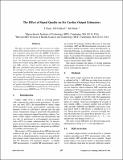The Effect of Signal Quality on Six Cardiac Output Estimators
Author(s)
Mark, Roger Greenwood; Clifford, Gari D.; Chen, Tiffany A.
DownloadChen-2009-The Effect of Signal Quality on Six Cardiac Output Estimators.pdf (137.7Kb)
PUBLISHER_POLICY
Publisher Policy
Article is made available in accordance with the publisher's policy and may be subject to US copyright law. Please refer to the publisher's site for terms of use.
Terms of use
Metadata
Show full item recordAbstract
The effect of signal quality on the accuracy of cardiac output (CO) estimation from arterial blood pressure (ABP) was evaluated using data from the MIMIC II database. Thermodilution CO (TCO) was the gold standard. A total of 121 records with 1,497 TCO measurements were used. Six lumped-parameter and systolic area CO estimators were tested, using ABP features and a robust heart rate (HR) estimate. Signal quality indices for ABP and HR were calculated using previously described metrics. For retrospective analysis, results showed that the Liljestrand method yielded the lowest error for all levels of signal quality. Increasing signal quality decreased error and only marginally reduced the amount of available data, as a signal quality level of 90% preserved sufficient data for almost continuous CO estimation. At the recommended signal quality thresholds, the lowest gross root mean square normalized error (RMSNE) was found to be 15.4% (or 0.74 L/min) and average RMSNE was 13.7% (0.71 L/min).
Date issued
2010-04Department
Harvard University--MIT Division of Health Sciences and TechnologyJournal
Computers in Cardiology
Publisher
Institute of Electrical and Electronics Engineers
Citation
Chen, T., G.D. Clifford, and R.G. Mark. “The effect of signal quality on six cardiac output estimators.” Computers in Cardiology, 2009. 2009. 197-200. © 2010 Institute of Electrical and Electronics Engineers.
Version: Final published version
ISBN
978-1-4244-7281-9
ISSN
0276−6574